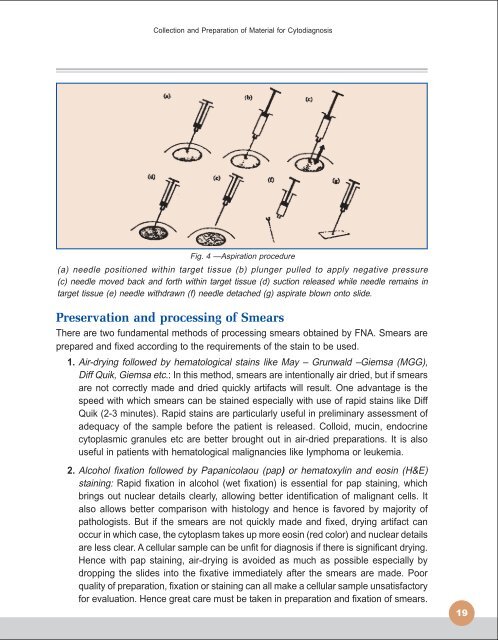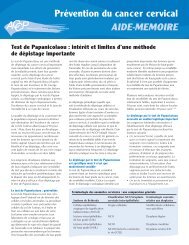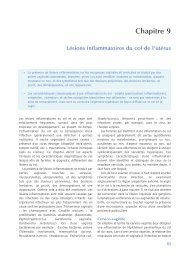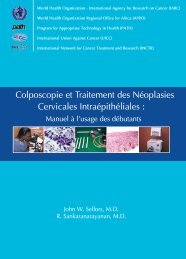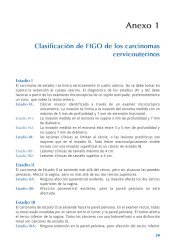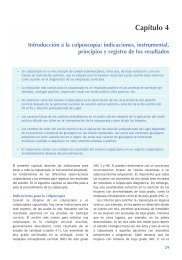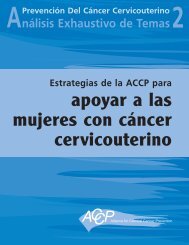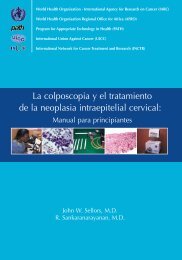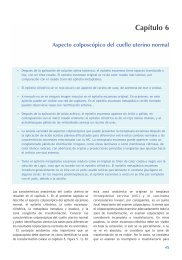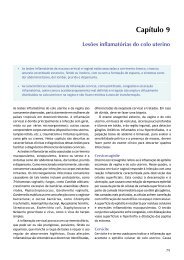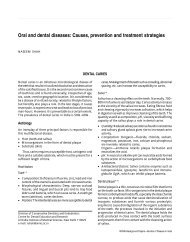Manual for Cytology - IARC Screening Group
Manual for Cytology - IARC Screening Group
Manual for Cytology - IARC Screening Group
Create successful ePaper yourself
Turn your PDF publications into a flip-book with our unique Google optimized e-Paper software.
Collection and Preparation of Material <strong>for</strong> Cytodiagnosis<br />
Fig. 4 —Aspiration procedure<br />
(a) needle positioned within target tissue (b) plunger pulled to apply negative pressure<br />
(c) needle moved back and <strong>for</strong>th within target tissue (d) suction released while needle remains in<br />
target tissue (e) needle withdrawn (f) needle detached (g) aspirate blown onto slide.<br />
Preservation and processing of Smears<br />
There are two fundamental methods of processing smears obtained by FNA. Smears are<br />
prepared and fixed according to the requirements of the stain to be used.<br />
1. Air-drying followed by hematological stains like May – Grunwald –Giemsa (MGG),<br />
Diff Quik, Giemsa etc.: In this method, smears are intentionally air dried, but if smears<br />
are not correctly made and dried quickly artifacts will result. One advantage is the<br />
speed with which smears can be stained especially with use of rapid stains like Diff<br />
Quik (2-3 minutes). Rapid stains are particularly useful in preliminary assessment of<br />
adequacy of the sample be<strong>for</strong>e the patient is released. Colloid, mucin, endocrine<br />
cytoplasmic granules etc are better brought out in air-dried preparations. It is also<br />
useful in patients with hematological malignancies like lymphoma or leukemia.<br />
2. Alcohol fixation followed by Papanicolaou (pap) or hematoxylin and eosin (H&E)<br />
staining: Rapid fixation in alcohol (wet fixation) is essential <strong>for</strong> pap staining, which<br />
brings out nuclear details clearly, allowing better identification of malignant cells. It<br />
also allows better comparison with histology and hence is favored by majority of<br />
pathologists. But if the smears are not quickly made and fixed, drying artifact can<br />
occur in which case, the cytoplasm takes up more eosin (red color) and nuclear details<br />
are less clear. A cellular sample can be unfit <strong>for</strong> diagnosis if there is significant drying.<br />
Hence with pap staining, air-drying is avoided as much as possible especially by<br />
dropping the slides into the fixative immediately after the smears are made. Poor<br />
quality of preparation, fixation or staining can all make a cellular sample unsatisfactory<br />
<strong>for</strong> evaluation. Hence great care must be taken in preparation and fixation of smears.<br />
19


